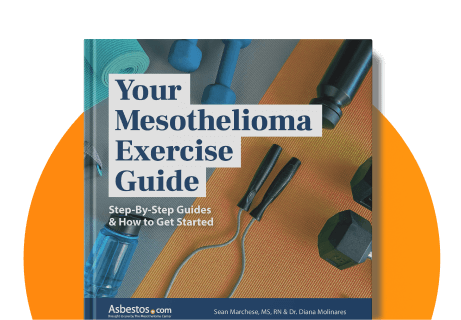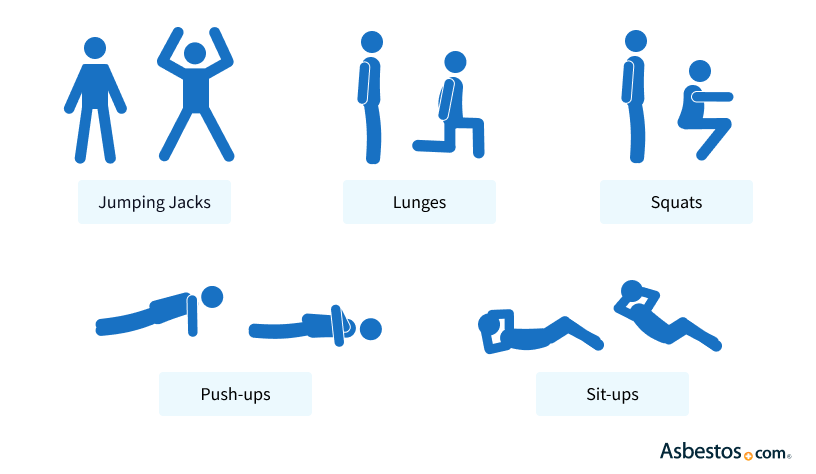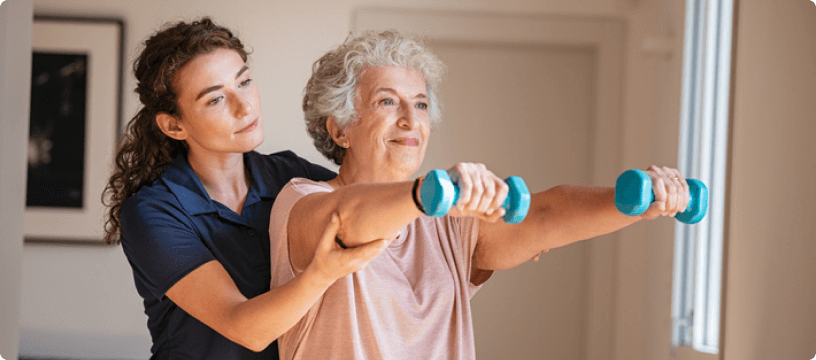
Exercise for Mesothelioma Cancer Patients
Oncologists highly recommend exercise during cancer treatment and recovery. Exercise lessens fatigue, increases muscle mass and strength, positively impacts mood and improves quality of life. Gentle activity a few days a week is all it takes to reap the benefits.
Importance of Exercise for Cancer Patients
Total bedrest represents an outdated approach to cancer treatment. Oncologists now recommend regular exercise because inactivity contributes to fatigue, poor appetite, muscular weakness and decreased quality of life.
People with mesothelioma cope with breathing difficulties, chest pain and reduced energy levels, all of which can affect their ability to exercise. According to multiple studies, exercise offers several benefits to cancer patients.
Benefits of Exercise for Cancer Patients
- Boosts energy and lessens fatigue
- Improves physical function
- Improves quality of life, mood and mental health
- Increases appetite
- Increases body mass, muscular strength, endurance and bone strength
- Reduces effects of stress on the body
- Reduces chemotherapy-related peripheral neuropathy
In 2017, a review of 100 studies on exercise and cancer was published in Oxford Academic. According to the review, cancer patients who exercise have a lower risk of cancer mortality and recurrence, and they experience fewer and less severe adverse effects.
Mesothelioma patients must avoid inactivity. Gentle activity adds up if you do it regularly. The body responds to repetition and develops endurance to handle more activity. Over time, you will feel more capable of exercise and will experience how regular activity improves your body, mind and quality of life.
Exercise and Cancer Research
Medical studies show that exercise is beneficial before, during and after cancer treatment. It offers a range of benefits for many different types of cancer. Research on different groups reveals the potential effects of exercise on cancer patients.
- In 2022, a mata-analysis of studies that evaluated the ability of exercise to improve fatigue in colorectal cancer survivors reported a small-to-moderate improvement. Steady improvement in fatigue was reported through a combination of aerobic and strength training.
- Lung cancer patients experienced decreased breathlessness and improved muscular strength from exercising twice a week for eight weeks, according to a 2015 review of exercise effects on lung cancer patients published in the Journal of Thoracic Oncology.
- Breast and colon cancer patients who exercise have fewer cancer recurrences and deaths compared to sedentary survivors. Seniors with cancer who exercise develop better overall health and cognitive function in addition to lowering their risk of falling.
- A 2014 Australian study reported improvements in respiratory function, energy levels and physical fitness among people with asbestosis and pleural disease who followed an eight-week exercise plan for pulmonary rehabilitation. This study did not include cancer patients, but the pulmonary limitations of people with asbestosis and pleural disease are similar to that of pleural mesothelioma.
Research shows that exercise increases a person’s chance of completing treatment — physically and psychologically. Exercising throughout treatment and recovery has been shown to reduce or prevent long-term and late effects of cancer treatment.

Enhance your well-being and build strength with safe, effective exercises for mesothelioma patients.
Get Your Free GuideSafe Exercises for Mesothelioma Patients
People with mesothelioma often cope with breathlessness and fatigue that limit activity and promote self-doubt in physical abilities. However, inactivity increases these symptoms and exercise improves them. The effects of inactivity are worse than risking injury from exercise. Plan to safely exercise by going slow and gentle.
Look at all forms of activity as exercise, including household chores and everyday tasks. Doing dishes, folding laundry, light gardening and walking around the block are gentle and productive ways to avoid inactivity. Finding ways to exercise around your home will help you integrate movement into your daily life.
Low-impact exercise is generally considered safe for most mesothelioma patients and it may improve their energy levels and quality of life.
Low-Impact Exercises
- Restorative or gentle yoga
- Tai chi and qigong
- Walking
- Swimming
- Cycling and elliptical training
- Lightweight strength training
Research shows that low-impact, moderate activity boosts immune function, while high-intensity activity suppresses the immune system. A 2013 study published in European Review of Aging and Physical Activity reported walking improved muscular strength, physical endurance and quality of life among cancer patients.
Any exercise is better than none. The American College of Sports Medicine offers exercise guidelines for cancer patients and recommends 30 minutes of activity five days a week. If 30 minutes seems like too much at once, build your endurance by exercising for 10 minutes three times throughout the day.
Types of Exercises to Avoid
Pleural mesothelioma patients should avoid intense cardiovascular exercise because it requires optimal lung function to perform safely. Instead, choose light to moderate cardio exercises such as walking, biking and slow swimming.
Patients should also take it easy when strength training upper body muscles such as the chest, shoulders and arms. These muscles are easily aggravated because tissue around the chest is weakened by the presence of tumors.
High-Intensity and High-Impact Exercises
- Hot or power yoga
- Fast cardiovascular training
- Long-distance running or cycling
- Heavy weightlifting
- Programs like CrossFit, P90X or boot camp classes
These intense forms of exercise suppress the immune system, deplete energy and increase breathlessness.
When climbing stairs, people with pleural mesothelioma can control their breathing to make ascension easier. Inhale as you lift a foot, and exhale as the foot touches the next step. The exhale gives your body an extra boost to mount the step.
People with peritoneal mesothelioma should avoid heavy weightlifting because of weakened core muscles in the abdomen and pelvis. Tumors in these areas impair muscle function and limit flexibility. Take precaution when twisting and bending during exercise. Go slow and be patient as you find exercises that suit your body’s needs and boundaries.
Exercise Precautions During Treatment and Recovery
Make exercise safe by adapting activity during treatment and recovery to your overall fitness level and your body’s current physical limitations.
For example, people undergoing chemotherapy feel fatigued for one to three days after infusion. Planning easy, gentle activity on those days will help you remain active without overdoing it. As fatigue lessens, you naturally return to normal activity and exercise.
Avoid swimming pools if undergoing radiation therapy because chlorine and bacteria irritates radiated skin.
Getting a cardiac health check prior to starting a fitness routine is important for seniors and people with a history of heart disease. Seek a fitness assessment from a doctor or personal trainer if you’re concerned about your physical abilities or injury.
Ask your cancer center if an exercise program is available. Many cancer centers throughout the country offer fitness assessments and exercise training from professionals who can develop a customized exercise plan for no extra charge.
Creating an Exercise Plan and Getting Others Involved
Creating a routine that’s easy to follow helps make exercise a habit. A complete exercise plan integrates cardiovascular training, muscle strength training, balance exercises and flexibility training.
Physical trainers often recommend alternating different types of training throughout the week, doing cardio one day, followed by muscle and flexibility training on other days. Alternating gives the body time to recover from each type of training.
Aim for cardiovascular exercise about two days a week, strength training two days a week and flexibility training at least once a week. Examples of cardiovascular exercise include walking, biking, swimming, dancing, Jazzercise and gentle calisthenics. Balancing exercises can be integrated into any category of exercise. Integrating balance exercises is especially beneficial for seniors to prevent falls.
Strength training should involve all major muscle groups. Start with light weights and consider using water bottles as dumbbells. Calisthenics are exercises that use your own body weight to strength train.

Flexibility training involves stretching all major muscle groups. Try a gentle or restorative yoga class as a relaxing way to improve flexibility and release stress. Yoga also helps to improve balance.
Involve Family and Friends
Getting others involved helps people commit and follow through with a fitness plan. People tend to perform better and enjoy exercise more with someone by their side to share the experience and benefits. You not only strengthen your body and mind but also your interpersonal relationships.
Positive peer pressure is a powerful motivator. You are far less likely to quit exercising when someone else is counting on you. When you make a commitment with someone, you’re less likely to give up, and they can hold you accountable with positive reinforcement.
I really feel that I need to exercise and be active, which I am doing. I also realize, however, that there are limits which must be respected and I am also doing that. Some people may say I am lazy but when my body tells me enough, I listen and stop.
Reach out to family and friends to find out who is able to support you in your exercise goals. Ask them to join you for walks, exercise classes or workout sessions. It’s also a good idea to ask someone to check in with you once a week to see how your exercise plan is going.

Ease your mesothelioma symptoms with the right food. See recipes designed for you.
Get My Free GuideWorking with a Physical Trainer
Another option to stay committed involves working with a physical trainer. Set exercise appointments with a fitness professional to ensure you’ll follow through and reduce concerns about exercising safely.

Some trainers are educated and certified to train people with cancer. The American College of Sports Medicine partnered with the American Cancer Society to teach trainers how to safely coach cancer patients. Certified Cancer Exercise Trainers (CETs) are specially trained to administer fitness assessments and develop exercise plans tailored to a cancer patient’s diagnosis, treatment plan and overall health.
Another safe option for people with cancer is Muscle Activation Techniques (MAT), a form of exercise training designed to balance and strengthen the muscular system. MAT is suitable for rehabilitation after injury, surgery and prolonged inactivity.
Eat Well to Exercise Better
Our bodies need food as fuel to function. Just like a car runs better on high-quality fuel, the quality of your food makes a difference on how well your body operates.
Healthy foods boost energy and unhealthy foods drag you down. The choices you make will either prepare you for exercise or make you feel like you don’t want to exercise.
Healthy Foods Improve Energy
Most of us know what foods are unhealthy. We know heavily processed, prepackaged foods high in sugar and low in nutrients are poor dietary choices. We know deep-fried foods are harder to digest and leave us feeling tired.
Energizing Foods
- Anti-inflammatory foods like low-sugar fruits, vegetables and cold-water fish provide energy and fight inflammation.
- Cooked foods require less energy to digest than raw foods. Salads with raw vegetables are OK to eat, but try to eat more cooked vegetables than raw when possible.
- Fish is a great source of protein that’s easier to digest than other proteins such as poultry and meat.
In general, whole foods are energizing, while processed foods are depleting. Whole foods include meat, fish, vegetables, fruits and whole grains. Processed foods include prepackaged meals, refined grains and sugar, cereals, canned produce and microwavable meals.
Avoiding a Poor Diet
What you eat makes a big impact on how you feel. Take the time and effort to choose healthy, energizing whole foods over processed, sugary foods, and you’ll feel lighter and more energized.
Foods to Limit
- Processed foods, including frozen meals and prepackaged items such as boxed mashed potatoes or canned foods
- Deep-fried foods such as french fries, chips, battered chicken, mozzarella sticks and donuts
- Inflammatory foods such as refined grains and sugar, alcohol, vegetable oils and artificial sugars
Starting to exercise regularly is a challenging habit to create. Set yourself up for success by getting others involved in your exercise, choosing healthy foods to eat and trying to get at least seven hours of sleep a night. With enough personal motivation and support from others, you can successfully commit to and follow through with an exercise plan and healthy lifestyle.
Recommended Reading





